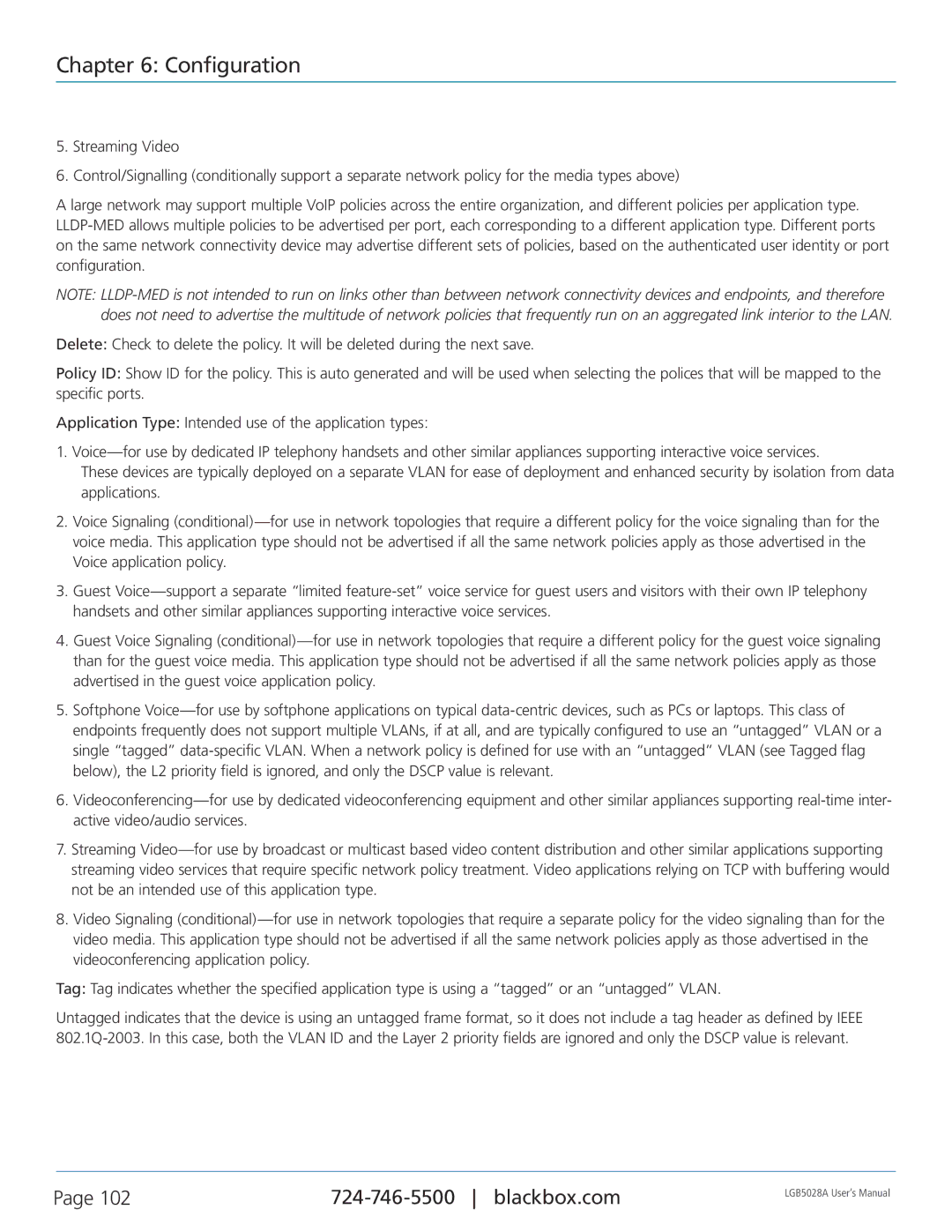Chapter 6: Configuration
5.Streaming Video
6.Control/Signalling (conditionally support a separate network policy for the media types above)
A large network may support multiple VoIP policies across the entire organization, and different policies per application type. LLDP-MED allows multiple policies to be advertised per port, each corresponding to a different application type. Different ports on the same network connectivity device may advertise different sets of policies, based on the authenticated user identity or port configuration.
NOTE: LLDP-MED is not intended to run on links other than between network connectivity devices and endpoints, and therefore does not need to advertise the multitude of network policies that frequently run on an aggregated link interior to the LAN.
Delete: Check to delete the policy. It will be deleted during the next save.
Policy ID: Show ID for the policy. This is auto generated and will be used when selecting the polices that will be mapped to the specific ports.
Application Type: Intended use of the application types:
1. Voice—for use by dedicated IP telephony handsets and other similar appliances supporting interactive voice services.
These devices are typically deployed on a separate VLAN for ease of deployment and enhanced security by isolation from data applications.
2.Voice Signaling (conditional)—for use in network topologies that require a different policy for the voice signaling than for the voice media. This application type should not be advertised if all the same network policies apply as those advertised in the Voice application policy.
3.Guest Voice—support a separate “limited feature-set” voice service for guest users and visitors with their own IP telephony handsets and other similar appliances supporting interactive voice services.
4.Guest Voice Signaling (conditional)—for use in network topologies that require a different policy for the guest voice signaling than for the guest voice media. This application type should not be advertised if all the same network policies apply as those advertised in the guest voice application policy.
5.Softphone Voice—for use by softphone applications on typical data-centric devices, such as PCs or laptops. This class of endpoints frequently does not support multiple VLANs, if at all, and are typically configured to use an “untagged” VLAN or a single “tagged” data-specific VLAN. When a network policy is defined for use with an “untagged” VLAN (see Tagged flag below), the L2 priority field is ignored, and only the DSCP value is relevant.
6.Videoconferencing—for use by dedicated videoconferencing equipment and other similar appliances supporting real-time inter- active video/audio services.
7.Streaming Video—for use by broadcast or multicast based video content distribution and other similar applications supporting streaming video services that require specific network policy treatment. Video applications relying on TCP with buffering would not be an intended use of this application type.
8.Video Signaling (conditional)—for use in network topologies that require a separate policy for the video signaling than for the video media. This application type should not be advertised if all the same network policies apply as those advertised in the videoconferencing application policy.
Tag: Tag indicates whether the specified application type is using a “tagged” or an “untagged” VLAN.
Untagged indicates that the device is using an untagged frame format, so it does not include a tag header as defined by IEEE 802.1Q-2003. In this case, both the VLAN ID and the Layer 2 priority fields are ignored and only the DSCP value is relevant.

